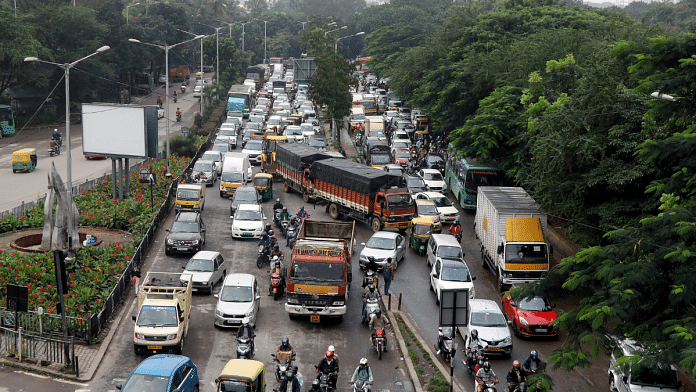New Delhi: Bengaluru has become the first Indian city to broach the idea of a congestion tax as a solution to the traffic crisis—the literal point at which India’s Silicon Valley comes to a standstill. While various suggestions and policy interventions have been floated in the past, Bengaluru, according to TomTom, has the third-worst traffic in the world, and is beaten only by Barranquilla in Colombia and Kolkata, another Indian city.
At a ‘high-level’ meeting, which had Biocon Managing Director Kiran Mazumdar Shaw, Chief Secretary Shalini Rajneesh, civic activist RK Misra, as well as undersecretaries, several measures to rid Bengaluru of its urban nightmare were discussed—one of which was a congestion tax. Commuters venturing into the city’s Outer Ring Road, a 60-kilometre stretch that serves a string tying together the city’s commercial centres, the tech corridor, and residential neighbourhoods, will automatically have to pay a certain sum of money in order to cross.
“If a car with only one occupant enters ORR, a congestion fee may be deducted automatically via FASTag. Cars with two or more occupants won’t be charged. This is not just about building infrastructure but also managing demand,” said Misra. “London and Singapore do it, and Bengaluru, as one of the fastest-growing cities, needs to consider it too.”
He is correct. If Bengaluru is to implement the congestion tax, it will join a select group of developed cities—many of which are seen as hallmarks of urbanisation. London, New York, Singapore, Stockholm, and Milan have all enforced congestion charges.
Also read: Brand Bengaluru is stuck on bad roads. MNCs, startups are saying ‘Hello Hyderabad’ now
Global models for congestion tax
Singapore, which is seen as the best model, introduced the tax exactly five decades ago, in 1975. The economy was rising, and the city was exploding. In 1965, according to a paper by the International Transport Forum, Singapore had 1,04,729 private vehicles. After 15 years, it had jumped by over a hundred per cent.
The scheme was observed as being “immediately successful” and traffic fell by 20 per cent in “just a few months.” Over the years, the system has evolved—integrating tech and the changing demands of consumers. In 1998, over 25 years ago, Singapore abandoned the manual system of enforcing the tax. It is now completely automated, to the point where authorities are contemplating a satellite-based system.
Across the globe, the reasons behind introducing a congestion tax are the same. However, these cities also rely extensively on a robust public transit system, which Bengaluru lacks.
A group of scholars, which included Nobel laureate Esther Duflo, questioned why congestion pricing schemes haven’t been implemented in developing nations, since their research found that commuters were “moderately flexible” when it came to changing schedules.
“Schedule flexibility alone suggests that commuters have a viable alternative to traveling during (congested) peak-hours, yet the overall gains from congestion pricing depend on the magnitude of the social benefits achieved by inducing commuters to avoid the peak hours,” reads the study.
But there are chinks in the armour. For instance, London, which remains one of the most traffic-heavy cities in the world, launched their congestion charging scheme in 2003. Yet, traffic continued. The traffic that stood to be reduced was replaced by taxis and other vehicles that didn’t have to comply with the scheme. But it still helped in improving the city’s air quality.
Another massive success story in Stockholm—Sweden is now transferring the scheme to the city of Gothenburg after congestion dropped by 30-50 per cent during the pilot project alone.
“Data reveals that the city has gained through the reduction in congestion, cleaner air, easier commercial transport and logistics, more money getting ploughed back into city infrastructure, and faster emergency vehicle response times,” says a report published by Observer Research Foundation.
(Edited by Ratan Priya)






